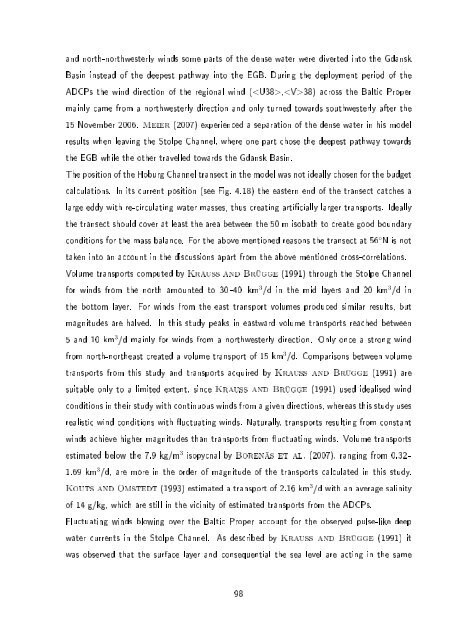Baltic Sea
Baltic Sea
Baltic Sea
Create successful ePaper yourself
Turn your PDF publications into a flip-book with our unique Google optimized e-Paper software.
and north-northwesterly winds some parts of the dense water were diverted into the Gdansk<br />
Basin instead of the deepest pathway into the EGB. During the deployment period of the<br />
ADCPs the wind direction of the regional wind (,38) across the <strong>Baltic</strong> Proper<br />
mainly came from a northwesterly direction and only turned towards southwesterly after the<br />
15 November 2006. Meier (2007) experienced a separation of the dense water in his model<br />
results when leaving the Stolpe Channel, where one part chose the deepest pathway towards<br />
the EGB while the other travelled towards the Gdansk Basin.<br />
The position of the Hoburg Channel transect in the model was not ideally chosen for the budget<br />
calculations. In its current position (see Fig. 4.18) the eastern end of the transect catches a<br />
large eddy with re-circulating water masses, thus creating articially larger transports. Ideally<br />
the transect should cover at least the area between the 50 m isobath to create good boundary<br />
conditions for the mass balance. For the above mentioned reasons the transect at 56 ◦ N is not<br />
taken into an account in the discussions apart from the above mentioned cross-correlations.<br />
Volume transports computed by Krauss and Brügge (1991) through the Stolpe Channel<br />
for winds from the north amounted to 30 -40 km 3 /d in the mid layers and 20 km 3 /d in<br />
the bottom layer. For winds from the east transport volumes produced similar results, but<br />
magnitudes are halved. In this study peaks in eastward volume transports reached between<br />
5 and 10 km 3 /d mainly for winds from a northwesterly direction. Only once a strong wind<br />
from north-northeast created a volume transport of 15 km 3 /d. Comparisons between volume<br />
transports from this study and transports acquired by Krauss and Brügge (1991) are<br />
suitable only to a limited extent, since Krauss and Brügge (1991) used idealised wind<br />
conditions in their study with continuous winds from a given directions, whereas this study uses<br />
realistic wind conditions with uctuating winds. Naturally, transports resulting from constant<br />
winds achieve higher magnitudes than transports from uctuating winds. Volume transports<br />
estimated below the 7.9 kg/m 3 isopycnal by Borenäs et al. (2007), ranging from 0.32 -<br />
1.69 km 3 /d, are more in the order of magnitude of the transports calculated in this study.<br />
Kouts and Omstedt (1993) estimated a transport of 2.16 km 3 /d with an average salinity<br />
of 14 g/kg, which are still in the vicinity of estimated transports from the ADCPs.<br />
Fluctuating winds blowing over the <strong>Baltic</strong> Proper account for the observed pulse-like deep<br />
water currents in the Stolpe Channel. As described by Krauss and Brügge (1991) it<br />
was observed that the surface layer and consequential the sea level are acting in the same<br />
98



